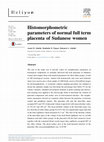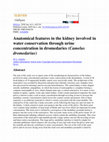Papers by Mohamed A H M E D Abdalla

Original Research Article
The aim of the study was to provide values for morphometric parameters of histological components... more The aim of the study was to provide values for morphometric parameters of histological components of normally delivered full term placentas of Sudanese women and compare them with reported parameters for other ethnic groups. A total of 200 histological sections, stained with hematoxylin and eosin and trichrome stains were used to give a final sample of 1000 fields saved as PowerPoint images for histomorphometry. A systematic random sampling procedure was adopted to ensure the optimum sample size that keeps the percentage error below 5% for the volume estimates. Standard stereological methods of point-counting and intersection counting were applied to the microscopic fields to determine the volumes of placental components and surface area of fetal-maternal interface. The morpho-metric parameters showed no variations either between the placentas or between central and peripheral regions. The placental villi and the intervillus space occupied 65% and 35% of placental volume respectively with mean absolute values of 318 cm 3 and 169 cm 3. The mean absolute volume of the intervillus space was less than that of other ethnic groups by 8.67% but was significantly larger than that of the fetal capillaries which measured 41.2 cm 3. The ratio of the absolute volume of the intervillus space to the volume of the fetal blood capillaries was 4:1 in both Sudanese and other ethnic groups. In the placental villi the fetal connective tissue together with the contained blood vessels larger than capillaries occupied 88% of the villus volume. The mean surface area of the fetal-maternal interface of the placental villi (syncytiotrophoblast) was 12.59 M 2 .

Original research article
The aim of this study was to report some of the morphological characteristics of the kidney invol... more The aim of this study was to report some of the morphological characteristics of the kidney involved in urine concentration and hence water conservation in the dromedaries. A total of 20 fresh kidneys of 10 apparently healthy camels were used in this study. The architecture of the renal pelvis was revealed by dissection and polyvinyl chloride corrosion casts. Samples were also processed for histology and for enzyme histochemistry. The camel kidney is bean shaped, smooth, multilobar, unipapillary, in which the fusion of renal papillae is complete forming a common renal papilla or crest, which channel urine into a central renal pelvis. It is more or less similar to equine, caprine, ovine and canine kidney. Under certain anatomical requisites the renal pelvis is known to play a role in urine concentration through recycling of urea to increase the medullary osmotic concentration which favors the counter-current mechanism. One of these requisites is an elaborate renal pelvis which is closely associated with the renal medulla. The renal pelvis of the camel has a main crescentic cavity following the long axis and curvature of the kidney. A thick extensive renal crest projects into the cavity of the pelvis. The thick renal crest contains large numbers of long loops of Henle and vasa recta which are important for urine concentration. The renal crest is formed by convergence of the medullary pyramids before it projects into the cavity of the renal pelvis. The crescentic main cavity of the pelvis forms 20-24 three dimensional radiating collateral recesses which contain the medullary pyramids. This close association of the renal pelvis and medulla provide a large surface area for the recycling of urea and hence urine concentration. This large pelvic-medullary interface is lined by simple low cuboidal epithelium which enhances the recycling of urea and water from the pelvic urine into the medulla and directly contributes to urine concentration. The rest of the wall of the renal pelvis and its recesses facing away from the renal crest and medullary pyramids is lined by impermeable transitional epithelium. Another feature is the intense activity of alkaline phosphatase demonstrated in the proximal convoluted tubules which indicates increased membrane transport. It is concluded that the kidney in dromedaries has the anatomical and histochemical requisites for the production of concentrated urine. These requisites enable the kidney to adequately contribute to the ability of the camel to conserve water and withstand the aridity of its habitat.

Uploads
Papers by Mohamed A H M E D Abdalla